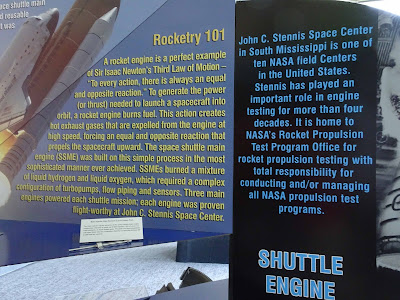We walked past the Deep
Ocean Explorer simulator and the nice young man running it asked if we would
like to go through the simulation. We
said sure.
He locked us in for our "decent".
Mark ready to take action!
Our mission was to locate and repair a leaking wellhead, using an Underwater Remote Operated Vehicle (ROV).
As we “descended” to the
bottom of the ocean the windows showed life in the ocean.
We found it!
After the simulator it was
time for our movie (an extra charge of $4 each). We saw Journey Into Space 3D.
Yikes!
It’s a great short film
about walking on the moon, continuously living in orbit and the next stop -
Mars.
A wonderful 3-D movie.
There were several things to see outside too.
Lunar Lander - Use to train for moon landings
In 1995, NOAA began the development of the Deep-ocean
Assessment and Reporting of Tsunami (DART) system to provide better warnings
for tsunami-prone communities.
TAO
NOAA completed the Tropical Atmosphere Ocean (TAO) array of
buoys for the detection of El Niño and La Niña in the Pacific Ocean in 1994. Today there are 70 permanent buoys moored
along the Pacific.
So, what is the “business end” of the Saturn V?
Infinity’s newest space exhibit, the Apollo 19 Saturn V
first stage, was originally slated for the cancelled Apollo 19 mission.
What is it? A
giant rocket stage boasting 5 massive F-1 engines. It's the first of the three stages of a
Saturn V rocket, the same rocket that was used by NASA to support the Apollo
program, and took Neil Armstrong and 23 others into orbit around the moon and
enabled 12 of them to actually walk on it.
Only this one never flew. It was one of several pieces
left over after Apollo 17, the last moon landing.
“F-1 Rocket
Engine – Developed by Rocketdyne in the 1950s, five F-1
engines were used to power the S-1C first stage of the Saturn V rocket that
launched humans to the moon during the Apollo Program. The engine
still is the most powerful single-chamber liquid-fueled rocket engine ever
developed. The Saturn V was the largest operational launch vehicle ever
produced. Standing over 363 feet high with its Apollo spacecraft payload,
it produced over 7.5 million pounds of thrust at lift-off.”
The staff announced that the Center was closing as we
raced through the gift shop. I didn’t
see any magnets that I liked so I didn’t buy one, but it would have been magnet
worthy.
They had to kick us out!



























































